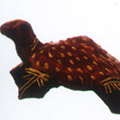Extremely delicate, the mats made with kora / sedge grass are highly prized and valued; Kora grass grows abundantly along the banks of the rivers and in marshy areas and the mats are woven both in Tamil Nadu and Kerala.
The process of creating the mat is complex and painstaking. In its original form the grass is green in colour and normally grows to a height of 3-4 feet. The grass for the mats is cut very finely while it is still green. The grass is collected in the months of September/ October and February/March. The inside white pith (choi) of the stem is removed with a sharp-edged knife while the outer part of the stem is used for weaving. The counts of the mat depend on how many strips the grass is cut into; the greater the number of strips from each stem the higher the count. The strips of grass are then dried in the hot sun. They are, however, never exposed to humidity, as they tend to turn black with the exposure. When the dried grass strips turn a yellowish greenish colour they are boiled in a pot of water and then dried again. The dried grass is made up into bundles and then soaked in running water. These bundles are weighed down with stones at both ends; they are then made to float in running streams of clean water. The weight of the stone is so adjusted that the grass remains just below the surface of the water. The grass is normally kept under water for three days, but sometimes it is kept under water for up to seven days, ensuring a very fine count. This wetting causes the grass to swell up to three times its original size. It is then dried again in the sun. The weaving is done on a floor loom. The process is slow and follows a basket weave pattern. The weft (or the grass) covers the warp entirely and the pattern formed has an interesting striped effect of its own. Once the weavings is complete, the mat is dried in the sun for a short while. It is then finished with a polishing stone.
Traditionally only two colours — red and black — were used on the mats. For dyeing the grass both natural and chemical dyes are used. The natural dye is taken from sappon or Brazil wood and is fixed with an alum mordant. With the introduction of chemical dyes a wide range of colours have been introduced into the mats. The warp on which the grass mats are woven was traditionally made of elephant aloe fibre. However, the weavers have now started using cotton or silk yarn as a substitute in the warp while weaving. The warp is made by the men while the weaving is done by the women. The mats produced include the 5 feet x 3 feet sleeping mat, prayer mats, table mats, and panthi mats which are used to sit on while eating. The designs on the mats are constantly evolving, changing from simple stripes to reproductions of monuments, animals, plants, and trees. The mats woven in Pattamadai are very fine with counts ranging from 100 to 140. Kora mats are extremely reliable and can be easily folded.
Gallery
YOUR VIEWS
PRACTITIONERS: INDIA
Access 70,000+ practitioners in 2500+ crafts across India.
BIBLIOGRAPHY
10,000+ listings on arts, crafts, design, heritage, culture etc.
GLOSSARY
Rich and often unfamiliar vocabulary of crafts and textiles.
SHOP at India InCH
Needs to be written.





